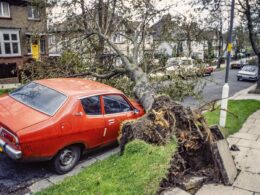The chances of life-threatening impact along the U.S. East Coast are expected to increase this weekend as Hurricane Ernesto continues its trek through the Atlantic Ocean.
Ernesto became a tropical storm on Monday after moving quickly through the Caribbean, and it evolved into a hurricane by Wednesday morning as it brought heavy rain and the threat of significant flooding to Puerto Rico and the Virgin Islands. The storm is expected to continue gaining strength this week, and its path is forecast to travel past Bermuda before winds are expected to reach Nova Scotia by late this weekend. Although the storm’s path won’t bring a direct landfall to the U.S., the storm poses fatal risks to parts of the East Coast.
Ernesto is the fifth named storm of the 2024 Atlantic hurricane season. As of Wednesday afternoon, the storm’s maximum sustained winds were measured at 75 mph, which is a Category 1 hurricane.
In its Wednesday morning update, the National Hurricane Center (NHC) warned of potentially life-threatening impact to the U.S.
“11 am EDT Wednesday, Aug. 14 Key Messages for Hurricane #Ernesto. Risk of life-threatening surf and rip currents is expected to increase along the U.S. East coast beaches this weekend,” the NHC posted on X, formerly Twitter.
11 am EDT Wednesday, Aug. 14 Key Messages for Hurricane #Ernesto.
Risk of life-threatening surf and rip currents is expected to increase along the U.S. East coast beaches this weekend. https://t.co/mxowVoRB8e pic.twitter.com/cGBJA7WcdX
— National Hurricane Center (@NHC_Atlantic) August 14, 2024
“Even though Ernesto is forecast to remain well offshore the U.S. East Coast, swells generated by the storm are expected to reach the area late this week and into the weekend,” the warning said. “Beach goers should be aware of a significant risk of life-threatening surf and rip currents, and stay out of the water if advised by lifeguards. Surf and rip currents are also possible on the Virgin Islands, Puerto Rico, the Dominican Republic, the Turks and Caicos, and the Bahamas during the next few days.”
Newsweek reached out to the NHC by email for comment.
Several drownings attributed to rip currents have occurred in the U.S. this year. Rip currents can be caused by hurricanes or tropical storms that cause disturbances in the ocean, and they can impact a beach even if a tropical storm is hundreds of miles away. As of Wednesday afternoon, the only rip current statements issued by the National Weather Service (NWS) were for Puerto Rico.
“Rip currents that can sweep even the best swimmers away from shore into deeper water where it becomes difficult to return to safety. High waves that can wash over jetties and sweep people and pets onto jagged rocks,” the statement said. “Rough surf may also knock you down. Large breaking waves will result in localized beach/dune structure erosion and dangerous swimming conditions.”
The Puerto Rico rip current statement will remain in place until Wednesday night.





